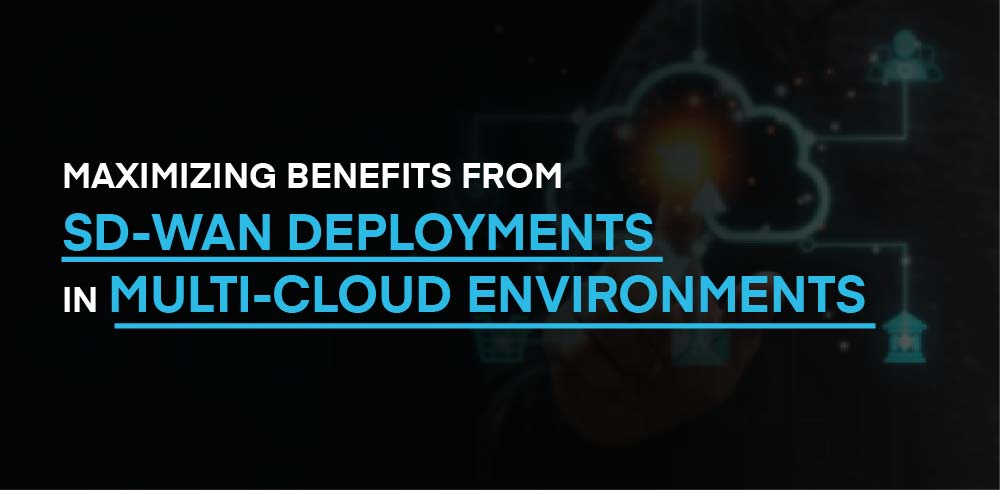
Multi-cloud operations, management, and control are complicated and require a well-engineered SD-WAN strategy for the best user experience.
The IT industry is experiencing a significant transformation. The unprecedented crisis and remote work environment have led to a greater dependency on cloud platforms. Cloud computing’s underlying benefits are longstanding, such as agility, scalability, innovation, and affordability. All the same, given the scale and nimbleness with which information goes through multiple applications these days, enterprises don’t want to risk their business continuity by relying on a stand-alone cloud service provider.
Almost all companies now strategically turn to a multi-cloud environment, for example, by using two or more Infrastructure as a Service (IaaS) platforms like Google Compute Engine and Amazon Web Services. This approach leads to a more coherent experience, provides flexibility, savings, and optimizes various applications’ workloads. Besides, multi-cloud platforms also help companies expand global cloud coverage, get custom support for specific applications, reduces downtime risks, avoid vendor lock-in, and benefit from the industry-leading solutions
Despite these innumerable benefits, the multi-cloud ecosystem’s management and control are challenging and need a well-crafted strategy. Every cloud environment is unique and requires different ways of working with transparency. As a result, it may be difficult for organizations to operate among diverse cloud-based ecosystems efficiently.
The problem can be further compounded because most IT departments do not possess the necessary skills or expertise to do multi-cloud environments. The skills required to manage the multi-cloud environment are remarkably different from those that IT teams have to manage on-site domains. It is impractical to self-manage such a critical transformation activity in-house without the required IT know-how.
In this challenging situation, businesses can consider the option of a managed SD-WAN service to accelerate their transition to a multi-cloud environment.
Establish secure and high-performance connectivity: For any organization, the adoption of a multi-cloud approach requires a thorough assessment. In a multi-cloud architecture, enterprises should iron out flaws related to data protection, security, and application performance.
Application-aware strategies: The conventional WAN methodology of backhaul of traffic on dedicated circuits to a central broadband access point has become less relevant in the cloud age. The SD-WAN can solve cross-cloud connectivity access by defining specific application-aware strategies and traffic priorities to connect users to the various cloud platforms.
For example, in a multi-cloud environment, SD-WAN can help prioritise Zoom video conferencing over an intranet portal access to ensure no lag time during the conference call because it could be a critical meeting in real-time.
Simplifies WAN: With SD-WAN, organizations can streamline their WAN infrastructure and minimise connectivity costs. It allows companies to use the most optimised links for various applications and workloads, resulting in bandwidth’s optimum utilisation. SD-WAN platforms can comprehend network traffic and deploy customised management and security policies based on users’ specific needs, devices, or applications to achieve an outstanding user experience.
Enhance network visibility: SD-WAN technology also provides IT, administrators, with every site’s network visibility through a centralized channel. The technology provides enhanced visibility, both from the perspective of applications as well as devices. One can monitor traffic for irregularities and obtain qualitative information around applications that need more bandwidth and those that do not operate according to expectations. Note that the lack of visibility of the number of applications and their bandwidth consumption modes can also make systems vulnerable and susceptible to attacks.
Heightened security: The greater visibility of the devices allows IT departments to implement specific security policies. SD-WAN empowers developers to leverage dependable APIs to reinforce network security protocols and streamline application lifecycle management.This information, along with appropriate analysis and automation processes, prevents the risk of undesirable latency, which stimulates the end-user experience. A majority of SD-WAN service providers offer data traffic encryption, contextual awareness capabilities, and virtual private networks that act like an added layer to secure the multi-cloud environment.
Questions to Ponder
Some of the key questions that organizations must deliberate before adopting the SD-WAN approach for
multi-cloud environments are:
- What types of cloud platforms do you need to access?
- Are they aligned with your business goals?
- Where are your cloud solutions hosted?
- How many sites/branch locations does your company have?
- Have you identified critical cloud-based apps that are critical to your enterprise?
- What are your future IT requirements?
Never forget that each organization has a different network and cloud ecosystem. Only a knowledgeable business consultant can help you assess your exact needs and reap the dividends of multi-cloud environments. To get the most out of SD-WAN technology for your company, contact us at Nexapp Technologies


